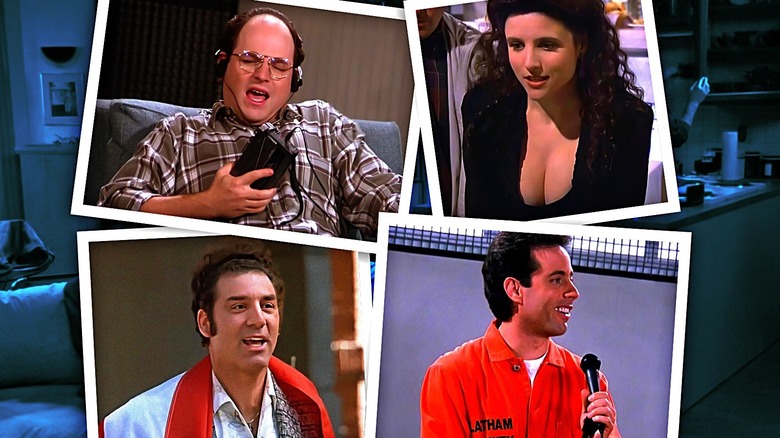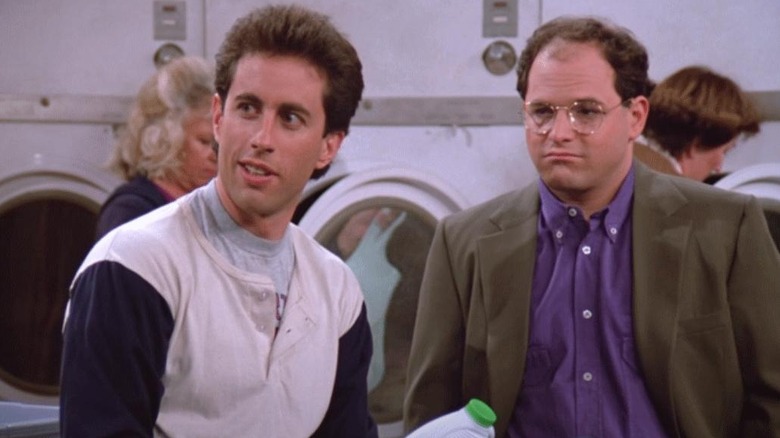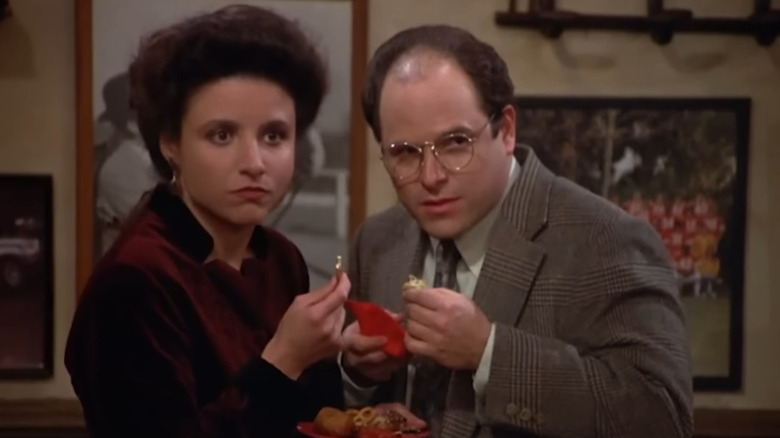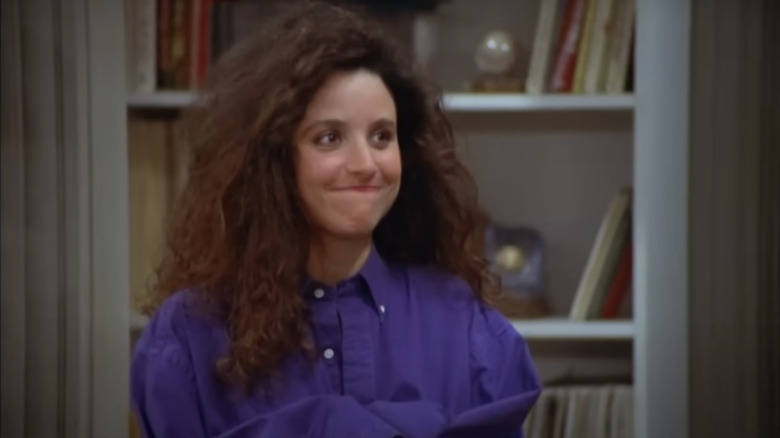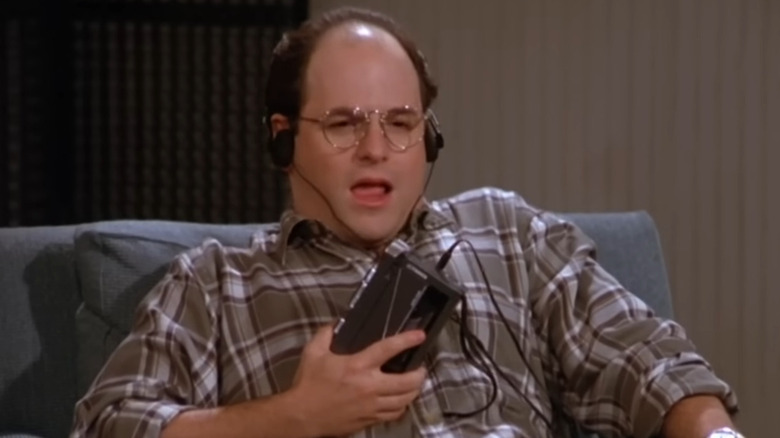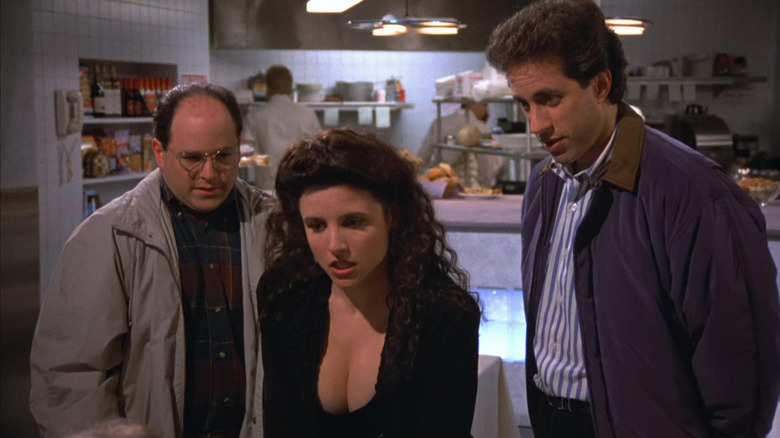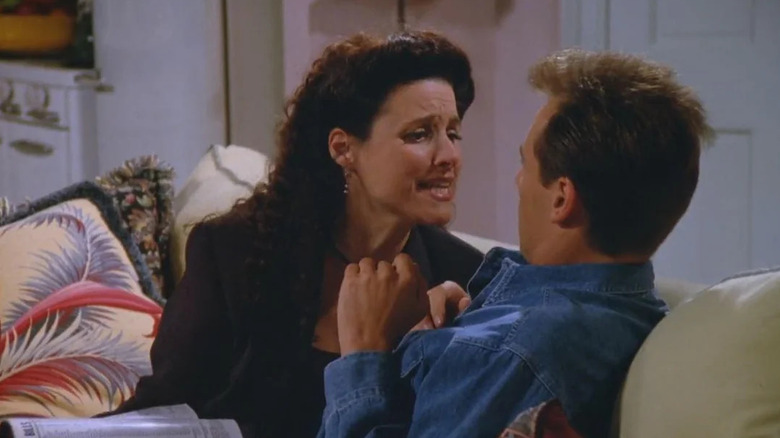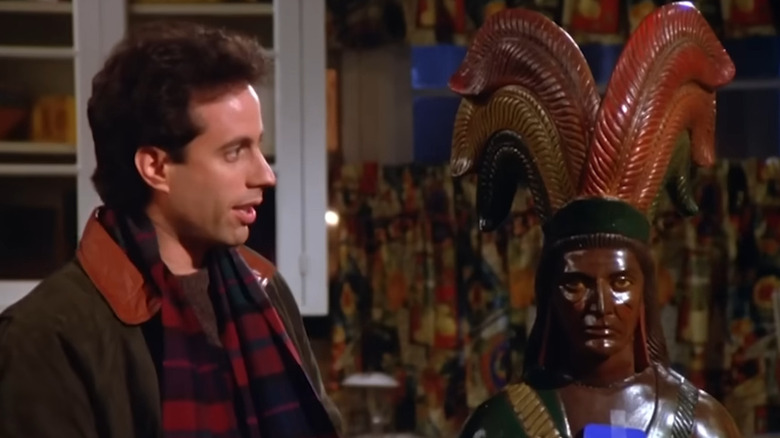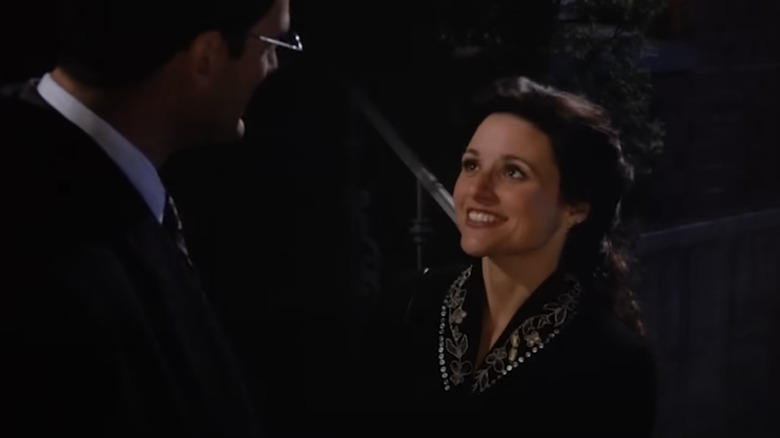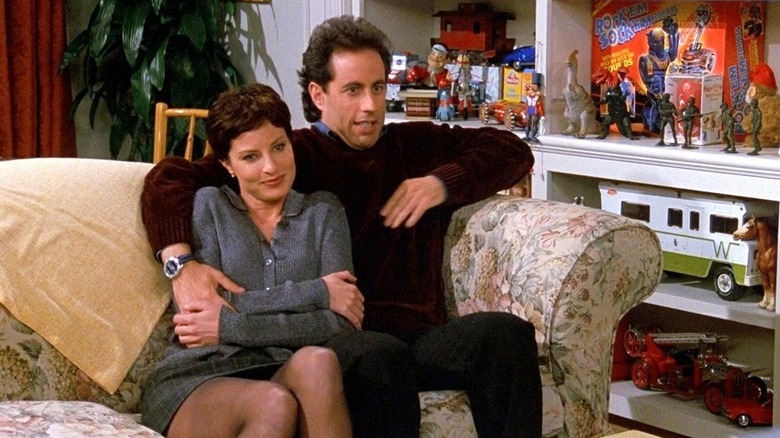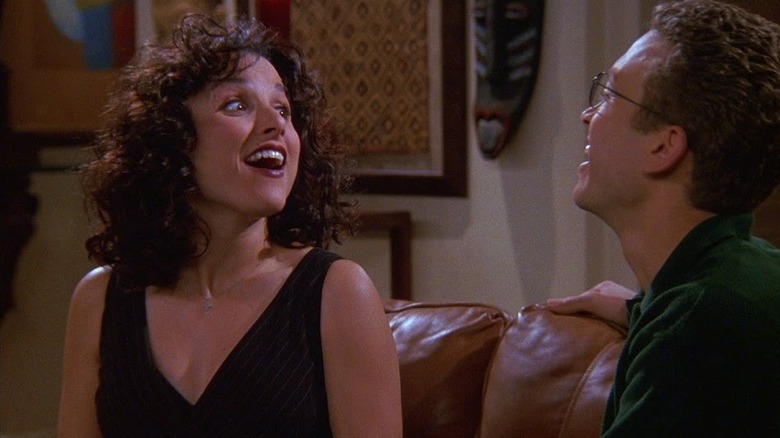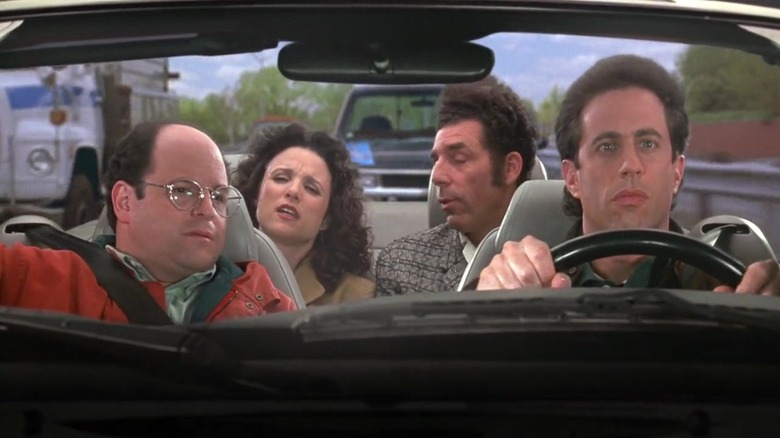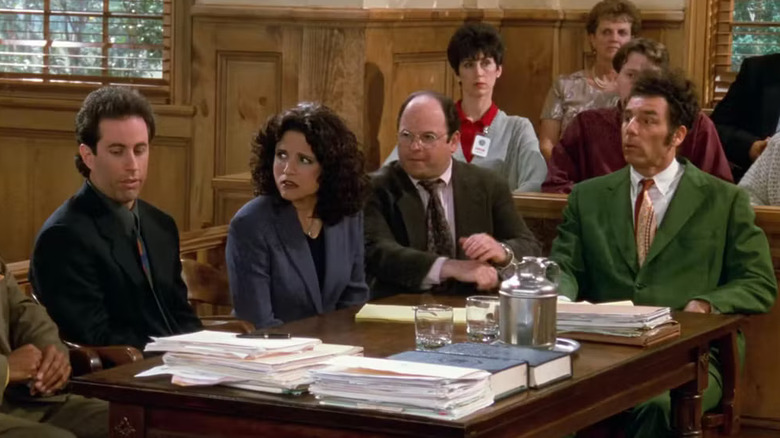12 Seinfeld Episodes That Aged Poorly
"Seinfeld" has been off the air for nearly 30 years, and yet it still dominates cultural conversation to this day. Whether it's the continued relevance of actors like Julia Louis-Dreyfus, co-creator Larry David's HBO series "Curb Your Enthusiasm" which references the show, or iconic phrases & sayings that only exist because of "Seinfeld," it's hard to forget about how popular the series was throughout the '90s.
Despite the show's popularity still thriving in 2025, there are a lot of episodes of "Seinfeld" that, as is typical for sitcoms of that era, haven't exactly aged super well. Plenty of shows like "Friends" or "Will & Grace" were notably behind the times when it comes to issues of LGBTQ+ representation, on-screen diversity, and other aspects of modern-day political correctness. However, there are comedy series on currently that still push the envelope, like "It's Always Sunny in Philadelphia," and surprisingly still hold up by today's standards.
For these 12 episodes of "Seinfeld," however, they were undoubtedly in poor taste even not long after they aired. Whether it's because of jokes that aren't as acceptable even by the most forgiving of audiences, or entire episodes in which the main cast acts despicable towards others, these episodes barely even scratch the surface of just how awful Jerry, Elaine, George, and Kramer could get.
The Seinfeld Chronicles
To start things off lightly, it's not uncommon for shows to change drastically from their pilots. Oftentimes, it's a matter of the showrunners realizing what's connecting with audiences, i.e, romantic chemistry between two characters, and nudging the show in that direction. Other times, entire characters and casting choices are changed between the first and second episodes, some that are incredibly vital to the show's future.
For "Seinfeld," its very first episode has aged poorly just by virtue of how different it is from what the show ends up being even a few episodes later. Most noticeable is the absence of Julia Louis-Dreyfus as Elaine. In her place is Lee Garlington playing Claire, a waitress at the diner frequented by Jerry and George Costanza (Jason Alexander). Michael Richards still appears, but Kramer was named Kessler, to avoid association with the character's namesake, a real-life neighbor of Larry David. The episode itself is rather unremarkable, though it does contain the recognizable voice that would define the show's later success.
The "Seinfeld" pilot was notoriously hated by test audiences, but by sheer luck and confidence in Seinfeld and David, the show was picked up for more episodes. It even took a few seasons for "Seinfeld" to really find its footing with audiences, but judging by this first episode, no one couldn't anticipated the massive pop culture phenomenon it was going to become.
The Revenge
Even by the second season of "Seinfeld," there were still huge missing pieces of the show's future dynamic. One of those missing pieces was Wayne Knight as Newman, Jerry's arch-nemesis who became one of the show's most popular and iconic recurring characters. The character's on-screen debut was, surprisingly, not until the third season of "Seinfeld," in the episode "The Suicide," when Newman spies on Jerry dating with a comatose suicide attemptee's girlfriend. However, Newman technically first appeared as an off-screen character a whole season earlier.
The episode "The Revenge" mainly centers on George recruiting Elaine to help enact revenge on his boss, but one subplot revolves around Kramer's issues with fellow apartment tenant Newman, who keeps calling Kramer threatening suicide, which Kramer is incredibly apathetic about. When Newman does eventually jump (from the second story), Kramer takes great joy in knowing he survived and just wanted attention.
Near the end of the episode, Newman (voiced by Larry David) calls out to Kramer in Jerry's apartment that he's on the roof, and Kramer continues egging him on to jump. In later airings of "The Revenge," Knight overdubbed David's original lines. Nevertheless, the episode's frequent mockery of suicide attempts feels pretty outdated now, but at least the mention of Newman would later give us a great character for Wayne Knight before his "Jurassic Park" role.
If you or someone you know is struggling or in crisis, help is available. Call or text 988 or chat 988lifeline.org
The Deal
Some have regarded "The Deal" as one of the worst episodes of "Seinfeld," but it also happens to be one that netted Larry David a nomination for Outstanding Writing for a Comedy Series at the Emmys. The episode only existed after NBC executives pressured David into writing an episode addressing the romantic relationship between Jerry and Elaine, who had already been established as exes. However, David was inspired to write "The Deal" after recalling a relationship of his own in which he and his partner attempted to have a sexual relationship without emotions.
As a result, "The Deal" explores what happens when Jerry and Elaine spontaneously decide to try out a physical relationship while promising it won't change their friendship. As the best '90s romantic-comedies will teach you, that is not entirely possible for most characters. Feelings quickly get in the way, resulting in a surprisingly emotional moment as the two argue about the rules they've established. By the end of the episode, the two have decided to remain a couple, though in the next episode of season two, they aren't anymore.
There's funny moments in "The Deal," and it's a great reminder how lucky the show was that a failed sitcom allowed Julia Louis-Dreyfus to join "Seinfeld," but it's also incredibly out of place in a show that typically doesn't explore feelings nor "will-they-won't-they" tropes of other sitcoms.
The Tape
Some protested when Julia Louis-Dreyfus said she doesn't think "Seinfeld" could get made today, but when you watch an episode like "The Tape," that's a very understandable statement. The episode premiered during the show's third season, and follows the consequences of Elaine recording an illicit message on Jerry's tape as a prank, which ultimately causes both Jerry and George to become uncontrollably attracted to her, albeit Jerry is unaware that the voice is Elaine while George does.
The hijinks that follow may be inevitable for a show centered on three male characters and one female, but Louis-Dreyfus was right in her estimation that a plot where the main cast is being as creepy as they are in this episode would not be accepted by today's audiences. At a certain point, Kramer decides he wants to shoot pornography in Jerry's apartment, bringing a camera over to interview Elaine and George, the latter of whom is still hiding his unresolved sexual feelings towards her.
The one positive part of this episode is that, after discovering Jerry and George's attraction to her as a result of this prank, Elaine is appropriately disgusted with them. It doesn't necessarily affect any of their behavior as the show continues, but it's a weirdly creepy episode for the three male characters.
The Shoes
It only took four seasons for "Seinfeld" to start getting meta, when both Jerry and George start working on a television series based on Seinfeld's stand-up career, called "Jerry." However, the fourth season's 16th episode "The Shoes" goes very off-the-rails in a lot of ways. For starters, George's plot in the episode revolves around him being caught staring at the cleavage of an NBC executive's 15-year-old daughter, which even for a character as pathetic as George is a really, really bad look.
Nevertheless, in order to persuade the NBC executive into not canning the show out of sheer principle, Jerry and George convince Elaine to wear her own cleavage-exposing dress to prove that a man will stare at any cleavage that enters his sight, no matter whose it is. It's a strange storyline for multiple reasons, partly that it's justifying being a creep towards an underage girl (which is especially notable given Seinfeld's own history with dating teenagers) and partly because it sees Jerry and George basically prostituting Elaine to keep their show in development.
At the very least, Elaine gets a small victory when she convinces Jerry and George to keep a character based on her in the "Jerry" series, though it shouldn't exactly surprise you to find out how she's able to convince them.
The Masseuse
"Seinfeld" would sometimes tread into the territory of referencing pop culture, albeit not intentionally. To understand the context for why this particular episode has aged like milk, it's worth remembering that the fifth season of "Seinfeld" aired in 1993. For the most part, "The Masseuse" a typically funny episode following Jerry growing frustrated that his masseuse girlfriend refuses to give him a massage, but eagerly gives one to Kramer. However, it's Elaine's story where the episode suffers from unfortunate timing.
In "The Masseuse," Elaine struggles with her new date, Joel Rifkin, which is infamously the name of a prolific serial killer in the late '80s and early '90s. She repeatedly tries to convince him to change his name, at one point reading a magazine and suggesting he change it to ... O.J... after O.J. Simpson. Yes, this episode aired over six months before the infamous murders occurred that tainted the football star's name forever, making Elaine's suggestion not a great one in hindsight.
Of course, "The Masseuse" is not the only time an inspiration from O.J. has been unfortunate, as the late Simpson is also the original inspiration for Marvel's The Falcon. On the positive side, this episode has aged well in one regard: it features the screen debut of future Emmy winner Jennifer Coolidge, who plays the titular girlfriend of Jerry. However, Coolidge landed her "Seinfeld" role with a resume full of lies claiming she'd been a busier actor than she actually was.
The Cigar Store Indian
It's not uncommon for popular shows like "The Simpsons" to have jokes that aged terribly, but "Seinfeld" is especially guilty of this in several episodes throughout its run. One notorious example is in the 5th season episode "The Cigar Store Indian," in which Jerry attempts to woo Elaine's friend Winona, played by Kimberly Norris, but keeps appearing racially insensitive to her, a Native American.
Jerry's comedy of errors starts off on an incredibly sour note when he presents Elaine and Winona with a "cigar store Indian," a type of wooden statue that is notably seen as incredibly offensive to individuals in the Native American community. After Winona is rightfully offended, Jerry is still somehow able to convince her to go on a date with him, only to continuously put his foot in his mouth regarding other racially insensitive situations, such as him avoiding calling their dinner plans a "reservation."
What's even more egregious about this episode in hindsight is that the original script written by Tom Gammill and Max Pross portrayed Winona as an animal rights activist with Jerry gifting her a moose head, but Seinfeld and David changed it to the cigar store Indian to be more outrageous. Nowadays, Seinfeld admits you could never get away with that storyline today, and even NBC's "The Today Show" host Al Roker singled out the episode as an example of institutional racism, even though the episode is poking fun at Jerry's insensitivity.
The Beard
Compared to when "Seinfeld" was on the air, there's a lot better representation for queer audiences, whether it be the mainstream success of important LGBTQ+ directors or influential LGBTQ+ movies. Sadly, "Seinfeld" was not part of the solution, despite one of the best "Seinfeld" episodes, season 4's "The Outing," coining the catchphrase "Not that there's anything wrong with that" as Jerry and George repeatedly deny their romantic involvement with each other.
However, only 2 seasons after "The Outing," "Seinfeld" took a few steps back with "The Beard," where Elaine starts to fall for her friend Robert (played by Robert Mailhouse), a gay man who asks Elaine to be his "beard" in front of his conservative boss. Elaine becomes determined to convince Robert to "change teams," even though Jerry tries to dissuade her by saying Robert's team is "only comfortable with their own equipment."
Given how often "Seinfeld" showcases its characters to be horrible, pathetic losers, it'd be understandable if Elaine's advances towards Robert were met with disgust or rejection. Surprisingly, Elaine does convince Robert to sleep with him, only for him to subsequently return to his former "team." The baseball metaphors are a fun game throughout the episode, but it's incredibly behind the times given that, by today's standards, lots of people play for both teams.
The Merv Griffin Show
For the ninth and final season of "Seinfeld," the show got pretty ambitious not just in its episode premises but in how far Jerry and co. were willing to go to be petty and selfish. One example of that is in the episode "The Merv Griffin Show," which primarily focuses on the high concept of Kramer discovering the trashed set for the titular talk show and setting it back up in his apartment. Meanwhile, Jerry's storyline sees him becoming obsessed with the collection of toys owned by his new girlfriend Celia (Julia Pennington), which she's stingy about letting him touch.
So, how does Jerry circumvent this difficult situation? If you guessed by drugging her, then either you've seen the episode before, or you're a very, very terrible person. Jerry's drugging of Celia starts innocently enough by giving her a nighttime pain reliever instead of a regular pain reliever, allowing him the freedom to play with her toys while she's out cold.
However, Jerry's plan really takes a turn for the sadistic when George and Elaine get involved, leading Jerry to straight-up poisoning Celia's food with wine and prescription tryptophan (a medication used for combating insomnia) to keep her unconscious for longer. The only person in the group who's rightfully against this plan is Kramer, but only because he thinks it'll reflect badly on his revived talk show.
The Wizard
"The Wizard" is regarded by many to actually be a groundbreaking episode of "Seinfeld" in showcasing how uncomfortable white people are when it comes to talking about race. At the same time, it's also still an episode by a white writer with an entirely white cast, making some of its musings on race a little tone-deaf. The episode revolves around Elaine's new boyfriend, Darryl (Samuel Bliss Cooper), who Jerry assumes is Black. For most sane people, that wouldn't be an issue, but for Elaine it is, because she believes Darryl is white.
After Darryl refers to him and Elaine as an interracial couple, Elaine's suspicions about Darryl's race grow larger, but she struggles with the concept of talking to him about it. There's some funny moments in that struggle, but there's also a lot of moments in the episode in which Elaine is meant to be receiving mixed signals about Darryl's race, but those signals end up coming off as just stereotypes that are outdated even for 1998.
Elaine ends up finding out at the end of the episode that not only is Darryl not Black, he was under the impression that she was Hispanic. One of the best moments in the episode comes when they discover this misunderstanding while a Black waitress (Bahni Turpin) serves them at the diner, quipping, "I'll give you a couple minutes to decide."
The Puerto Rican Day
There's a lot that's noteworthy about "The Puerto Rican Day," one of the last-ever episodes of "Seinfeld" before its series finale. By this point, Larry David left "Seinfeld" but had agreed to return to write the two-part final episode, meaning "The Puerto Rican Day" was a group effort of the show's then-staff. Even with the most credited writers ever for an episode of "Seinfeld," it ended up really ticking people off for a few scenes that aren't just politically incorrect, but downright disrespectful to Puerto Rican culture.
The episode features Jerry, George, Elaine, and Kramer getting stuck in traffic due to a Puerto Rican Day Parade, causing frustration among the four main characters. As a result, one scene has Kramer burn a Puerto Rican flag. This moment, as well as other jokes at the expense of Puerto Rico, drew backlash and even protests against the network, resulting in the controversial episode being banned from airing on NBC.
It's not surprising that, given the loud reaction to the episode's immense insensitivity, that many consider it the worst episode of "Seinfeld," but despite its controversy, the episode remains intact on streaming services like Netflix, and returned for syndicated re-runs.
The Finale
There have been lots of scenes that ruined entire movies and TV shows, but one of the most infamous examples of this was the two-part finale of "Seinfeld," aptly titled "The Finale." When it aired, it was one of the most-watched television finales of all time, next to the likes of "M*A*S*H" and "Cheers," which made its failure among audiences all the more embarrassing. In the episode, the main four are arrested after making fun of a man getting robbed on the street, citing Massachusetts' "Good Samaritan Law."
However, once the quartet end up in court, they discover that the prosecutors for their case have summoned witnesses consisting of numerous characters who attest to the negative characters of Jerry, Elaine, George, and Kramer. After being convicted, the four end up sitting in a jail cell in the series' final moment, which even despite his confidence in the episode, Seinfeld says that's what he regrets the most about the finale.
The episode certainly goes down in the pantheon of bad TV finales, given that every joke is reliant on the audience's knowledge of previous episodes. However, it did pave the way for a tremendous finale for Larry David's follow-up "Curb Your Enthusiasm," where he similarly faces conviction after a court trial stacked with character witnesses, only for Seinfeld himself to walk David out of jail after a mistrial is declared. In hindsight, some even think the "Curb Your Enthusiasm" finale should've doubled down on the controversial "Seinfeld" ending.
